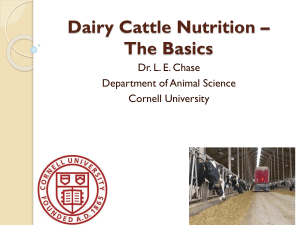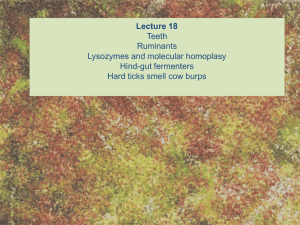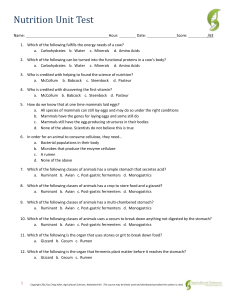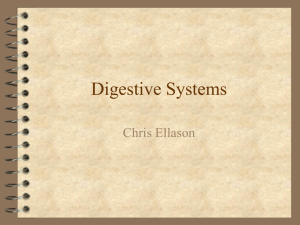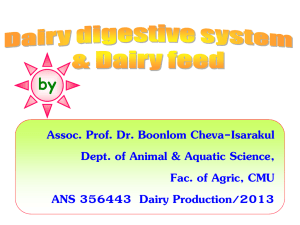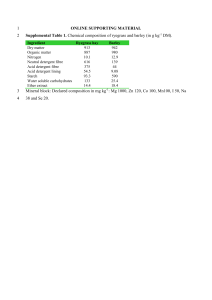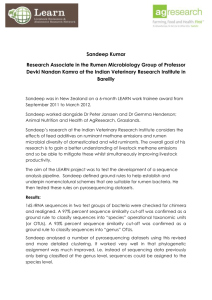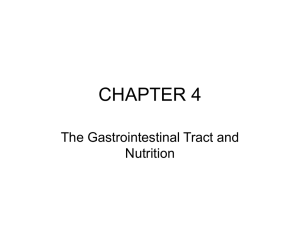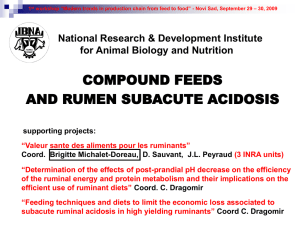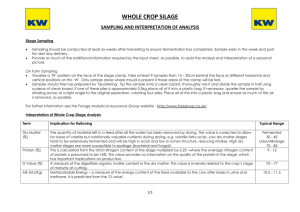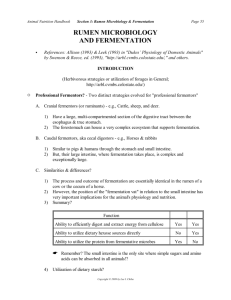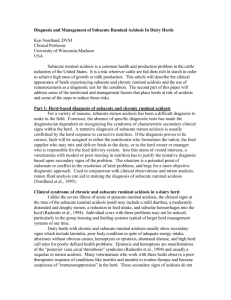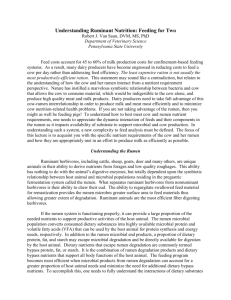The Magical, Mystical Rumen
advertisement
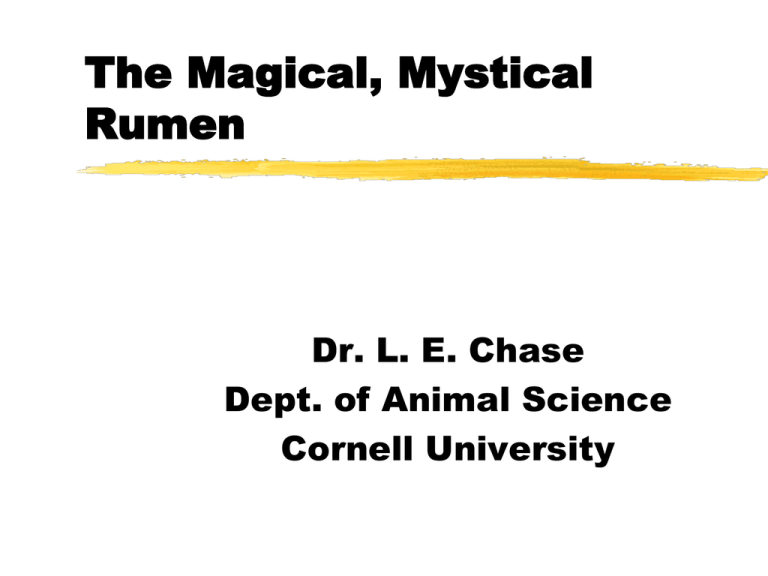
The Magical, Mystical Rumen Dr. L. E. Chase Dept. of Animal Science Cornell University Objectives of Feeding Dairy Cattle Balanced Total Ration and Good Feed Management Maximize dry matter intakes Optimize milk production Good health and reproduction PROFITABILITY!! Growth Dairy Cattle Nutrition What are we feeding? A dairy cow? Rumen bugs? Bug Managers Don’t think of it as feeding the cow, you are feeding the bacteria or “bugs” that live in the cow’s rumen. The bugs in the rumen take the nutrients in the feed and turn it into milk, milk fat & protein, growth, and to nourish their growing calf. The Rumen Environment Anaerobic Constant temperature = 39 C pH = 6 to 6.6 Buffered by saliva 10-15 % dry matter Constant mixing = motility Generalized equation for ruminal fermentation and metabolism Carbohydrates + Rumen bugs + Fiber fermentors Starch + sugar fermentors Nitrogen sources + Ammonia, peptides, and AA Anaerobic environment + Good environment to grow (pH, water, temperature) Volatile Fatty Acids + Acetate, propionate, butryate = More rumen bugs + Microbial protein Methane (CH4) + CO2 + H2O + Heat Rumen Bacteria 109 - 1011 per gram 0.3 - 50 um in size 60-65% CP 80% of CP is true protein Fiber digesting bacteria Convert fiber to VFA’s (mainly acetate) - Cellulose, hemicellulose Like a higher rumen pH (>6) Require ammonia as a nitrogen source Slow generation interval - 8 – 10 hours to double Sugar % Starch Digesting Bacteria Convert sugars and starches to VFA’s - mainly propionate Like a lower rumen pH (5.5 to 6) Rapid generation interval - Can double in < 1 hour Use ammonia, amino acids or peptides as nitrogen sources Rumen protozoa 105 - 106 per gram 20 - 200 um in size May account for 50% of the total rumen microbial mass Not well understood Cows & Rumens - A Symbiotic Relationship Stage 1 - The cow provides housing & nutrients for microbial growth Stage 2 - The host animal utilizes the rumen microorganisms passing to the intestines as a source of nutrients What Does the Cow Provide? Low oxygen environment Constant temperature (99 - 106 0 F) Food for the bugs Neutral environment Garbage removal What Do the Bugs Provide? Fiber digestion High quality protein VFA’s for energy and building blocks for milk synthesis Synthesis of B vitamins Amino acid balancing % of Protein Requirement from Microbial Protein 100 80 g N/g OM 60 20 40 30 20 40 0 55 77 Milk, lbs/day 99 Rumen CHO/Protein Balance Good amino acid management begins with good CHO management in order to produce a high & consistent amount of AA from microbes Hoover What’s the Economics of Microbial Protein? Corn sil. – DM Alf. Hay Oat sil. Wet brewers Cracked corn Ground corn Ration A 16.2 2.2 3.5 4.8 9.5 Ration B 20 2.7 5 5 10.9 Economics of Microbial Protein SBM – 48 HT SBM Soy Hulls Anim. Prot. Bypass Fat Ration A 8 6 .5 .75 Ration B 7.5 0.5 Economics of Microbial Protein Milk, lbs/day MP – bact., g MP –RUP., g Feed cost, $ IOFC, $ 97 1369 1694 4.05 9.33 100 1582 1591 3.52 10.73 Microbial Composition 4.4% 12.0% 21.1% 62.5% Protein CHO Fat Ash Urine Liver Milk Recycled Feed Crude Protein Urea Recycled Ammonia Carbohydrates VFA Manure Excess Protein Microbes Escape Feed Protein Dr. M. B. Hall - Univ. of Florida Rume n Absorbed Protein Production & Maintenance Ration, Eating Rate & Saliva Production Feed Pellets Eating, Saliva, lb/minute teaspoons/lb 0.79 1.0 Fresh grass 0.62 1.5 Silage 0.55 2.0 Dried grass 0.18 5.0 Hay 0.15 6.0 Forage Particle Size and Chewing - Corn Silage 30 25 20 min/lb. NDF 15 10 5 0 3/4 inch 1/2 inch 1/4 inch Particle Size - Case Study 900 cow dairy Things going well Then a large number of fresh cow DA’s within 1-2 weeks Feed company was called by the producer and asked what was wrong with the ration Corn Silage Particle Size 60 50 40 Bunker % 30 Tower 20 10 0 Top Middle Pan “To Feed the Cow, You Need to First Feed the Bugs” “Happy” Bugs = Milk, Health and Profit The Manure is Your Mirror What To Look For: 1. Corn Kernels 2. Grain 3. Long Pieces of Fiber 4. Consistency shaving cream The Big Balancing Act... Environment Effective fiber Rumen Fermentable Carbohydrates Salivary buffers Ruminal mixing Acid production Stall comfort standing vs lying Heat stress Over-crowding Diet consistency Dr. W. Stone - Cornell University Conclusion Need a balanced ration of carbohydrates, protein, vitamins, minerals, fiber & effective fiber for optimal rumen function, microbial growth=maximum VFA production Milk yields Good health Milk components





